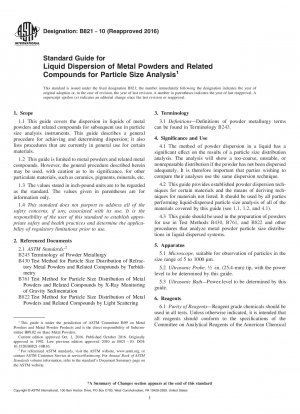ASTM B821-10(2016)
Standard Guide for Liquid Dispersion of Metal Powders and Related Compounds for Particle Size Analysis
- Standard No.
- ASTM B821-10(2016)
- Release Date
- 2010
- Published By
- American Society for Testing and Materials (ASTM)
- Status
- Replace By
- ASTM B821-22
- Latest
- ASTM B821-23
- Scope
4.1 The method of powder dispersion in a liquid has a significant effect on the results of a particle size distribution analysis. The analysis will show a too-coarse, unstable, or nonrepeatable distribution if the powder has not been dispersed adequately. It is therefore important that parties wishing to compare their analyses use the same dispersion technique.
4.2 This guide provides established powder dispersion techniques for certain materials and the means of deriving techniques for materials not listed. It should be used by all parties performing liquid-dispersed particle size analysis of all of the materials covered by this guide (see 1.1, 1.2, and 4.1).
4.3 This guide should be used in the preparation of powders for use in Test Methods B430, B761, and B822 and other procedures that analyze metal powder particle size distributions in liquid-dispersed systems.
(A) As described in Test Method B430.(B) Tween 21, chemically known as polyoxyethylene6 sorbitan monolaurate, is manufactured by Croda International PLC, and is available from various chemical suppliers.(C) Three to five drops Tween 21 in 30 to 50 mL water.1.1 This guide covers the dispersion in liquids of metal powders and related compounds for subsequent use in particle size analysis instruments. This guide describes a general procedure for achieving and determining dispersion; it also lists procedures that are currently in general use for certain materials.
1.2 This guide is limited to metal powders and related metal compounds. However, the general procedure described herein may be used, with caution as to its significance, for other particulate materials, such as ceramics, pigments, minerals, etc.
1.3 The values stated in inch-pound units are to be regarded as the standard. The values given in parentheses are for information only.
1.4 This standard does not purport to address all of the safety concerns, if any, associated with its use. It is the responsibility of the user of this standard to establish appropriate safety and health practices and determine the applicability of regulatory limitations prior to use.
ASTM B821-10(2016) Referenced Document
- ASTM B243 Standard Terminology of Powder Metallurgy
- ASTM B430 Standard Test Method for Particle Size Distribution of Refractory Metal Powders and Related Compounds by Turbidimetry
- ASTM B761 Standard Test Method for Particle Size Distribution of Powders and Related Compounds by X-Ray Monitoring of Gravity Sedimentation
- ASTM B822 Standard Test Method for Particle Size Distribution of Metal Powders and Related Compounds by Light Scattering
ASTM B821-10(2016) history
- 2023 ASTM B821-23 Standard Guide for Liquid Dispersion of Metal Powders and Related Compounds for Particle Size Analysis
- 2022 ASTM B821-22 Standard Guide for Liquid Dispersion of Metal Powders and Related Compounds for Particle Size Analysis
- 2010 ASTM B821-10(2016) Standard Guide for Liquid Dispersion of Metal Powders and Related Compounds for Particle Size Analysis
- 2010 ASTM B821-10 Standard Guide for Liquid Dispersion of Metal Powders and Related Compounds for Particle Size Analysis
- 2002 ASTM B821-02(2007) Standard Guide for Liquid Dispersion of Metal Powders and Related Compounds for Particle Size Analysis
- 2002 ASTM B821-02 Standard Guide for Liquid Dispersion of Metal Powders and Related Compounds for Particle Size Analysis
- 1992 ASTM B821-92(1997) Standard Guide for Liquid Dispersion of Metal Powders and Related Compounds for Particle Size Analysis
